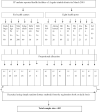Artemether-lumefantrin treatment adherence among uncomplicated plasmodium falciparum malaria patients, visiting public health facilities in AsgedeTsimbla district, Tigray, Ethiopia: a cross-sectional study
- PMID: 33168093
- PMCID: PMC7653737
- DOI: 10.1186/s13756-020-00846-y
Artemether-lumefantrin treatment adherence among uncomplicated plasmodium falciparum malaria patients, visiting public health facilities in AsgedeTsimbla district, Tigray, Ethiopia: a cross-sectional study
Abstract
Background: Ethiopia has set a goal to eliminate malaria by 2030; Artemether-lumefantrine (AL) is put as one of the cornerstone strategies for uncomplicated plasmodium falciparum malaria treatment. However, only focusing on prescribing of the treatment without assessing patients' adherence could lead to the resistance of the drug. In Ethiopia, there is limited evidence about patients' adherence to AL and its influencing factors. Therefore, this study aimed at addressing this information gap.
Methods: A health facility based cross-sectional study was employed. Participants were selected using simple random sampling technique from registration books of the public health facilities in AsgedeTsimbla. Data were collected from March 24th to April 30th, 2018. We interviewed participants using a pre-tested structured questionnaire, and the blister pack was also inspected at their homes on day 4. Data were entered into Epi-Info and analyzed using SPSS 21. Odds ratios with 95% Confidence Intervals were estimated and the level of significance was declared at p-value ≤ 0.05.
Results: A total of 384 study participants were interviewed with a response rate of 95.5%. The overall AL adherence was 53.6% (95% CI 48.4-58.3%). Children aged < 5 years [AOR: 0.4, 95% CI (0.2-0.8)], and being treated in health post [AOR: 0.3, 95% CI (0.1-0.5)] were more likely to show AL adherence whereas illiteracy [AOR: 9.4, 95% CI (4.2-21.3)], didn't know the consequence of discontinued AL [AOR: 4.0, 95% CI (2.1-7.6)], had concomitant drugs [AOR: 2.5, 95% CI (1.4-4.5)], and stopped/saved drug when improved before tablet got finished [AOR: 3.2, 95% CI (1.7-5.9)] were factors less likely to be associated with AL adherence.
Conclusion: AL adherence was low. Children aged < 5 years, and being treated in health post were determinants of AL adherence whereas illiteracy, didn't know the consequence of discontinued the drug, had concomitant drugs, and stopped/saved drug when improved before tablet got finished were factors that hindered the AL adherence. Stakeholders should emphasize designing appropriate strategies including educational interventions to increase the AL adherence and prevent drug resistance. Further research should be conducted to evaluate AL resistance.
Keywords: Adherence; Artemether–lumefantrine; Plasmodium falciparum.
Conflict of interest statement
The authors declare that they have no competing interests.
Figures
Similar articles
-
Adherence to a six-dose regimen of artemether-lumefantrine among uncomplicated Plasmodium falciparum patients in the Tigray Region, Ethiopia.Malar J. 2011 Dec 5;10:349. doi: 10.1186/1475-2875-10-349. Malar J. 2011. PMID: 22141751 Free PMC article.
-
Therapeutic efficacy of artemether-lumefantrine in the treatment of uncomplicated Plasmodium falciparum malaria in Chewaka District, Ethiopia.Malar J. 2020 Jul 10;19(1):240. doi: 10.1186/s12936-020-03307-4. Malar J. 2020. PMID: 32650784 Free PMC article.
-
Therapeutic efficacy of artemether-lumefantrine in the treatment of uncomplicated Plasmodium falciparum malaria in Arba Minch Zuria District, Gamo Zone, Southwest Ethiopia.Malar J. 2024 Sep 17;23(1):282. doi: 10.1186/s12936-024-05087-7. Malar J. 2024. PMID: 39289715 Free PMC article.
-
Atovaquone-proguanil for treating uncomplicated Plasmodium falciparum malaria.Cochrane Database Syst Rev. 2021 Jan 15;1(1):CD004529. doi: 10.1002/14651858.CD004529.pub3. Cochrane Database Syst Rev. 2021. PMID: 33459345 Free PMC article.
-
Efficacy and safety of artemether-lumefantrine for treatment of uncomplicated Plasmodium falciparum malaria in Ethiopia: a systematic review and meta-analysis.Malar J. 2021 May 6;20(1):213. doi: 10.1186/s12936-021-03745-8. Malar J. 2021. PMID: 33957925 Free PMC article.
Cited by
-
Current Status and the Epidemiology of Malaria in the Middle East Region and Beyond.Microorganisms. 2021 Feb 9;9(2):338. doi: 10.3390/microorganisms9020338. Microorganisms. 2021. PMID: 33572053 Free PMC article. Review.
-
Impact of health education intervention on the patients' adherence to malaria artemisinin-based combination therapy in Kamuli District, Uganda.Malar J. 2025 Jun 12;24(1):189. doi: 10.1186/s12936-025-05444-0. Malar J. 2025. PMID: 40506709 Free PMC article.
-
Factors influencing patients' adherence to malaria artemisinin-based combination therapy in Kamuli District, Uganda.Malar J. 2024 Jan 2;23(1):1. doi: 10.1186/s12936-023-04824-8. Malar J. 2024. PMID: 38166910 Free PMC article.
-
Determinants of Patients' Adherence to Malaria Treatment in the Democratic Republic of the Congo.Trop Med Infect Dis. 2022 Jul 18;7(7):138. doi: 10.3390/tropicalmed7070138. Trop Med Infect Dis. 2022. PMID: 35878149 Free PMC article.
-
Current Epidemiological Characteristics of Imported Malaria, Vector Control Status and Malaria Elimination Prospects in the Gulf Cooperation Council (GCC) Countries.Microorganisms. 2021 Jul 2;9(7):1431. doi: 10.3390/microorganisms9071431. Microorganisms. 2021. PMID: 34361867 Free PMC article. Review.
References
-
- World Health Organization. “Antimalarial drug combination therapy. Report of a WHOtechnical consultation,”WHO/CDS/RBM 2001. Geneva, Switzerland; 2001.
-
- World Health Organization. World Malaria Report 2017; available from https://www.who.int/malaria/publications/world-malaria-report-2017/repor.... Accessed 28 December, 2018. World Health Organization. 2017. 196 p.
-
- World Health Organization. WHO | Guidelines for the treatment of malaria. Third edition. WHO. 2015.
-
- Ethiopian Federal Minstry of Health . Malaria case management training manual for health professionals in Ethiopia. Addis Ababa, Federal Minstry of Health: Participants Manual; 2016.
-
- Bruxvoort K, Festo C, Kalolella A, Cairns M, Lyaruu P, Kenani M, Kachur SP, Goodman CSD. Cluster randomized trial of text message reminders to retail staff in tanzanian drug shops dispensing Artemether–lumefantrine: Effect on dispenser knowledge and patient adherence. Am J Trop Med Hyg. 2014;91:844. doi: 10.4269/ajtmh.14-0126. - DOI - PMC - PubMed
MeSH terms
Substances
LinkOut - more resources
Full Text Sources
Miscellaneous



